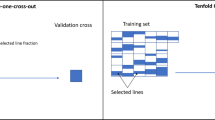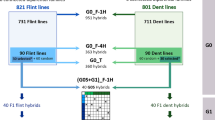Abstract
Key message
Training population optimization algorithms are useful for efficiently training genomic prediction models for single-cross performance, especially if the population is extended beyond only realized crosses to all possible single crosses.
Abstract
Genomic prediction of single-cross performance could allow effective evaluation of all possible single crosses between all inbreds developed in a hybrid breeding program. The objectives of the present study were to investigate the effect of different levels of relatedness on genomic predictive ability of single crosses, evaluate the usefulness of deterministic formula to forecast prediction accuracy in advance, and determine the potential for TRS optimization based on prediction error variance (PEVmean) and coefficient of determination (CDmean) criteria. We used 481 single crosses made by crossing 89 random recombinant inbred lines (RILs) belonging to the Iowa stiff stalk synthetic group with 103 random RILs belonging to the non-stiff stalk synthetic heterotic group. As expected, predictive ability was enhanced by ensuring close relationships between TRSs and target sets, even when TRS sizes were smaller. We found that designing a TRS based on PEVmean or CDmean criteria is useful for increasing the efficiency of genomic prediction of maize single crosses. We went further and extended the sampling space from that of all observed single crosses to all possible single crosses, providing a much larger genetic space within which to design a training population. Using all possible single crosses increased the advantage of the PEVmean and CDmean methods based on expected prediction accuracy. This finding suggests that it may be worthwhile using an optimization algorithm to select a training population from all possible single crosses to maximize efficiency in training accurate models for hybrid genomic prediction.





Similar content being viewed by others
Abbreviations
- BSSS:
-
Iowa stiff stalk synthetic
- CD:
-
Coefficient of determination
- DHL:
-
Doubled haploid line
- NSSS:
-
Non-stiff stalk synthetic
- PEV:
-
Prediction error variance
- RIL:
-
Recombinant inbred lines
- TRS:
-
Training set
- TS:
-
Test set
References
Akdemir D (2017) STPGA: selection of training populations with a genetic algorithm. BioRxiv. https://doi.org/10.1101/111989
Akdemir D, Isidro-Sánchez J (2019) Design of training populations for selective phenotyping in genomic prediction. Sci Rep 9:1446. https://doi.org/10.1038/s41598-018-38081-6
Akdemir D, Isidro-Sanchez J, Jannink J-L (2015) Optimization of genomic selection training populations with a genetic algorithm. Genet Sel Evol 47:38
Albrecht T, Wimmer V, Auinger H-J et al (2011) Genome-based prediction of testcross values in maize. Theor Appl Genet 123:339
Albrecht T, Auinger H-J, Wimmer V et al (2014) Genome-based prediction of maize hybrid performance across genetic groups, testers, locations, and years. Theor Appl Genet 127:1375–1386
Araus JL, Cairns JE (2014) Field high-throughput phenotyping: the new crop breeding frontier. Trends Plant Sci 19:52–61
Bernardo R (1994) Prediction of maize single-cross performance using RFLPs and information from related hybrids. Crop Sci 34:20–25. https://doi.org/10.2135/cropsci1994.0011183X003400010003x
Bernardo R (2002) Breeding for quantitative traits in plants. Stemma Press, Woodbury
Bernardo R (2020) Breeding for quantitative traits in plants, 3rd edn. Stemma Press, Woodbury
Butler DG, Cullis BR, Gilmour AR, Gogel BJ (2009) Mixed models for S language environments: ASReml-R reference manual. Training and development series, no. QE02001 QLD Department of Primary Industries and Fisheries, Brisbane
Clark SA, Hickey JM, Daetwyler HD, van der Werf JH (2012) The importance of information on relatives for the prediction of genomic breeding values and the implications for the makeup of reference data sets in livestock breeding schemes. Genet Sel Evol 44:4
Daetwyler HD, Villanueva B, Woolliams JA (2008) Accuracy of predicting the genetic risk of disease using a genome-wide approach. PLoS ONE 3(10):e3395. https://doi.org/10.1371/journal.pone.0003395
Daetwyler HD, Pong-Wong R, Villanueva B, Woolliams JA (2010) The impact of genetic architecture on genome-wide evaluation methods. Genetics 185:1021–1031
Dekkers JM (2007) Marker-assisted selection for commercial crossbred performance. J Anim Sci 85:2104–2114
Elshire RJ, Glaubitz JC, Sun Q et al (2011) A robust, simple genotyping-by-sequencing (GBS) approach for high diversity species. PLoS ONE 6:e19379
Endelman JB (2011) Ridge regression and other kernels for genomic selection with R package rrBLUP. Plant Genome 4:250–255
Fristche-Neto R, Akdemir D, Jannink J-L (2018) Accuracy of genomic selection to predict maize single-crosses obtained through different mating designs. Theor Appl Genet 131:1153–1162. https://doi.org/10.1007/s00122-018-3068-8
Glaubitz JC, Casstevens TM, Lu F et al (2014) TASSEL-GBS: a high capacity genotyping by sequencing analysis pipeline. PLoS ONE 9:e90346
Guo T, Yu X, Li X et al (2019) Optimal designs for genomic selection in hybrid crops. Mol Plant 12:390–401. https://doi.org/10.1016/j.molp.2018.12.022
Isidro J, Jannink J-L, Akdemir D et al (2015) Training set optimization under population structure in genomic selection. Theor Appl Genet 128:145–158
Jacobson A, Lian L, Zhong S, Bernardo R (2014) General combining ability model for genome-wide selection in a biparental cross. Crop Sci 54:895–905
Jannink J-L, Lorenz AJ, Iwata H (2010) Genomic selection in plant breeding: from theory to practice. Brief Funct Genom 9:166–177. https://doi.org/10.1093/bfgp/elq001
Kadam DC, Lorenz AJ (2019) Evaluation of nonparametric models for genomic prediction of early-stage single crosses in maize. Crop Sci 59:1411–1423. https://doi.org/10.2135/cropsci2017.11.0668
Kadam DC, Potts SM, Bohn MO et al (2016) Genomic prediction of single crosses in the early stages of a maize hybrid breeding pipeline. G3 Genes Genomes Genet 6:3443–3453
Laloë D (1993) Precision and information in linear models of genetic evaluation. Genet Sel Evol 25:557–576
Lin Z, Hayes BJ, Daetwyler HD (2014) Genomic selection in crops, trees and forages: a review. Crop Past Sci 65:1177–1191
Lorenz A, Nice L (2017) Training population design and resource allocation for genomic selection in plant breeding. In: Varshney RK, Roorkiwal M, Sorrells ME (eds) Genomic selection for crop improvement. Springer, Berlin, pp 7–22
Lorenz AJ, Chao S, Asoro FG et al (2011) Genomic selection in plant breeding: knowledge and prospects. In: Sparks DL (ed) Advances in agronomy. Elsevier, Berlin, pp 77–123
Massman JM, Gordillo A, Lorenzana RE, Bernardo R (2013) Genomewide predictions from maize single-cross data. Theor Appl Genet 126:13–22
Meuwissen THE, Hayes BJ, Goddard ME (2001) Prediction of total genetic value using genome-wide dense marker maps. Genetics 157:1819–1829
Reif JC, Hallauer AR, Melchinger AE (2005) Heterosis and heterotic patterns in maize. Maydica 50:215–223
Reif JC, Gumpert F-M, Fischer S, Melchinger AE (2007) Impact of interpopulation divergence on additive and dominance variance in hybrid populations. Genetics 176:1931–1934. https://doi.org/10.1534/genetics.107.074146
Rincent R, Laloë D, Nicolas S et al (2012) Maximizing the reliability of genomic selection by optimizing the calibration set of reference individuals: comparison of methods in two diverse groups of maize inbreds (Zea mays L.). Genetics 192:715–728
Sarinelli JM, Murphy JP, Tyagi P, Holland JB, Johnson JW, Mergoum M, Mason RE, Baber A, Harrison S, Sutton R, Griffey CA, Brown-Guedira G (2019) Training population selection and use of fixed effects to optimize genomic predictions in a historical USA wheat panel. Theor Appl Genet 132:1247–1261
Schulz-Streeck T, Ogutu JO, Karaman Z et al (2012) Genomic selection using multiple populations. Crop Sci 52:2453–2461
Seye AI, Bauland C, Charcosset A, Moreau L (2020) Revisiting hybrid breeding designs using genomic predictions: simulations highlight the superiority of incomplete factorials between segregating families over topcross designs. Theor Appl Genet 133:1995–2010
Technow F, Riedelsheimer C, Schrag TA, Melchinger AE (2012) Genomic prediction of hybrid performance in maize with models incorporating dominance and population specific marker effects. Theor Appl Genet 125:1181–1194
Technow F, Schrag TA, Schipprack W et al (2014) Genome properties and prospects of genomic prediction of hybrid performance in a breeding program of maize. Genetics 197:1343–1355
VanRaden PM (2008) Efficient methods to compute genomic predictions. J Dairy Sci 91:4414–4423
Xu S, Zhu D, Zhang Q (2014) Prediction hybrid performance in rice using genomic best linear unbiased prediction. Proc Natl Acad Sci USA 111:12456–12461
Zhao Y, Gowda M, Liu W et al (2012) Accuracy of genomic selection in European maize elite breeding populations. Theor Appl Genet 124:769–776
Zhao Y, Li Z, Liu G et al (2015) Genome-based establishment of a high-yielding heterotic pattern for hybrid wheat breeding. Proc Natl Acad Sci USA 112:15624–15629. https://doi.org/10.1073/pnas.1514547112
Acknowledgements
This research was partially supported by grants from the Nebraska Corn Board and National Research Initiative or Agriculture and Food Research Initiative Competitive Grants Program (Grant No. 2012-67013-19460) from the USDA National Institute of Food and Agriculture. D.C. Kadam was supported by an Indian Council of Agricultural Research International Fellowship. We are indebted to Ronal Haarman of Corteva (formerly Dupont Pioneer) for growing trials and collecting data at the York, NE location.
Author information
Authors and Affiliations
Contributions
DCK contributed to the study design, collected the data, analyzed the data, and wrote the manuscript. ORR contributed data. AJL led design of the study, supervised data analysis, and wrote the manuscript.
Corresponding author
Ethics declarations
Conflict of interest
The authors declare they have no conflict of interest.
Additional information
Communicated by Matthias Frisch.
Publisher's Note
Springer Nature remains neutral with regard to jurisdictional claims in published maps and institutional affiliations.
Electronic supplementary material
Below is the link to the electronic supplementary material.
Rights and permissions
About this article
Cite this article
Kadam, D.C., Rodriguez, O.R. & Lorenz, A.J. Optimization of training sets for genomic prediction of early-stage single crosses in maize. Theor Appl Genet 134, 687–699 (2021). https://doi.org/10.1007/s00122-020-03722-w
Received:
Accepted:
Published:
Issue Date:
DOI: https://doi.org/10.1007/s00122-020-03722-w




